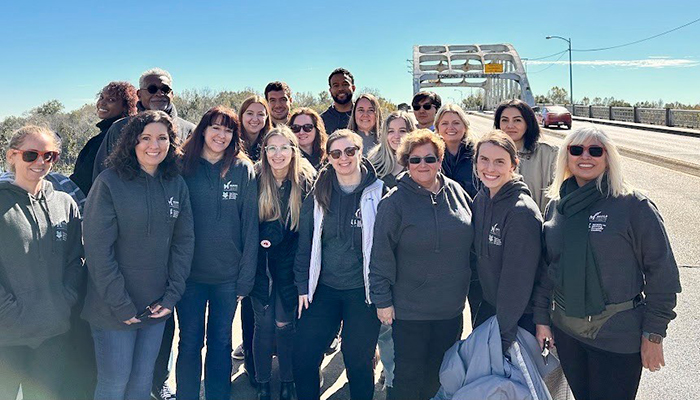In This Story

What began as a road trip among colleagues to see important landmarks became a deeply moving—and motivating—journey into the heart of a nation’s darkness.
Some 20 incarceration, jurisprudence, and healthcare academics and professionals—as well as several doctoral students—spent three days in mid-November touring locations in Georgia and Alabama that were the battlegrounds in the fight for civil rights in the U.S. in the 1950s and ‘60s.
Most of the visitors to historic sites in Atlanta, Selma, Montgomery, and Birmingham were from the Schar School of Policy and Government’s Center for Advancing Correctional Excellence (ACE!), including doctoral students from the Schar School and George Mason University’s criminology department, rounded out with colleagues from Sam Houston State University, Arizona State University, Norwich University, and Justice Systems Partnership.
The trip was important, said ACE! founding director Faye Taxman, “to truly understand racism in the United States and how it influences our current criminal legal organizations. We need to understand how slavery and the old and new Jim Crow laws affected and continue to affect how our legal systems operate.”
According to ACE! studies, health systems, incarceration practices, and affiliated legal system processes continue to be influenced by racial prejudices throughout the country. The visit to the landmarks in the U.S. South “helped explain the long legacy of oppression and disenfranchisement in the United States,” said Taxman. Ultimately, the hope is to “lay the foundation for the road to redemption for fair and justice processes,” which describes ACE!’s mission.
The landmarks visited included the Birmingham Civil Rights Institute, the Rosa Parks Museum, the town of Selma and the Edmund Pettus Bridge, the Equal Justice Institute’s Legacy Museum and the Equal Justice Initiative’s Legacy Museum and National Memorial for Peace and Justice—ominously referred to as “the lynching museum”—and the Ebenezer Baptist Church at the Martin Luther King, Jr., National Historical Park where the namesake was baptized, ordained, and served as co-pastor.
The landmarks were brought to life by special lecturers who participated in the historic events affiliated with the sites.
One of the speakers was JoAnne Bland, who was 11 years old when she walked across the Edmund Pettus Bridge on March 7, 1965, with others, including the late U.S. Rep. John Lewis (D), to support voting rights. (She and others were beaten by the police). Bland announced she is now building Foot Soliders Park in Selma to preserve the memories of the events that contributed to acquiring voting rights for Blacks and minorities.
The group also heard from U.S. Senator Raphael Warnock (D), as he gave a Sunday sermon at Ebenezer Baptist Church devoted to the importance of civil rights, lifting up others, and staying focused on one’s mission in life. (At this time, Warnock is in a runoff election with Herschel Walker [R].)
While the trip was extraordinary for the insights it offered, Taxman noted that the 12-year-old ACE! “has always operated as a family that learns and works together,” she said. “This tour gave us opportunities to bring together our enormous family dedicated to social justice with doctoral students working on studies focused on understanding and reforming the legal justice system.
“This experience solidified the reasons why we do the work we do and reminded us of the continued importance of hearing the voices of those that lived through the fight for civil rights.”
